






Lisa Yankowski is part of the team of gardeners that answers your questions. Contact the team on the Ask A Gardener page.
Gardeners have questions — and we have answers. Whether you're planning your first garden and have questions about design, or you've been gardening for years and need ideas for dealing with a persistent pest, ask your question on the Ask A Gardener page.
Questions from our customers inspire new articles, blog posts, Facebook discussions and innovative products. You'll find some of the most frequently asked questions answered below:
How do I plant bareroot strawberries? Strawberries should be planted 12-18" apart, so the crown — the growth point where roots and shoots join — is level with the soil surface.
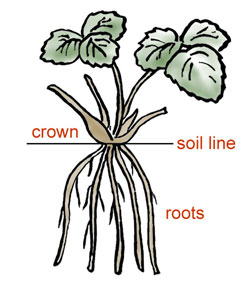
For more details, watch the video and read the article: Planting and Growing Strawberries.
When can I put my tomato plants outside? Wait until the danger of frost has passed and the weather has settled. Use the last average frost date in your area as a guide. For example, in Burlington, VT, our average last frost date is mid May. So, we traditionally set out our tomato transplants around Memorial Day. About a week before transplanting your seedlings, start hardening them off by gradually exposing them to outdoor conditions. Place the pots in a protected spot outdoors (partly shaded, out of the wind) for a few hours each day, bringing them in at night. Gradually expose them to more and more sunshine and wind. (A cold frame is a great place to harden off plants.) Once you plant your seedlings in the garden, keep an eye on the forecast. Every year is different and a late cold snap can stunt or kill plants. Always be prepared to cover plants with a row cover, such as our GardenQuilt Cover, if a late cold snap threatens. Eager to get an earlier start? With Tomato Teepees, you can plant a few weeks earlier.
For more detailed information, read Step by Step: Growing Tomatoes from Seed to Harvest.
How do I start an asparagus patch? If you love asparagus and want to grow some yourself, waste no time in getting started. Even with the best of care, an asparagus bed won't hit its stride for several years. But once that happens, the bed will produce an abundant crop of spears spring after spring for at least the next 20 to 30 years. Learn how in the article How to Grow Asparagus.
Can I grow lettuce on a sunny windowsill? Yes, if you have a south-facing window, where you can expect about 12 hours of light each day. Using a light garden, you can grow lettuce pretty much anywhere you want — even in an office cubicle. To learn more, read Growing Lettuce Indoors.
Can I grow bougainvillea indoors? Absolutely, as long as you have a sunny spot, such as a south-facing window where temperatures remain about 65 degrees F. Experts say you should let them go dry between waterings, so the leaves start to wilt just a bit. When the colorful bracts fade and float to the floor, the plant can be a little messy. Other than that, it's a relatively easy-care houseplant. For more information, read the blog post Growing Bougainvillea Indoors.
This season, I grew vegetables in a 3 x 6 raised bed. Do I need to worry about crop rotation next year?: The idea of rotating crops is both for minimizing pest problems and avoiding nutrient deficiencies (among other things). However, it's not necessary to remove all the soil in their beds or planters. Instead, focus on rejuvenating the existing soil and preventing carry-over of disease.
At season's end, remove all of the spent plant material. This includes plant foliage and roots. Do not wait till it's time to plant again. Compost the healthy stuff; toss diseased or insect-affected material in the trash. If you're feeling ambitious, plant a cover crop, such as winter rye or winter wheat, which will nurture beneficial microorganisms to help control disease pathogens.
Before you plant again, add lots of microbe-rich organic matter to the remaining soil. Good options are Worm Power, Container Booster Mix and compost. Another good addition is granular, slow-release fertilizer, such as our All-Purpose Fertilizer or a crop-specific blend, such as our Organic Tomato Fertilizer.
If there's a known, soil-borne pest that's caused trouble with your crops in the past, be prepared to keep it under control in the new season.
I just bought 40 lbs. of potatoes at the farmer's market. How do I store them? Rub off any large clumps of dirt (potatoes should never be washed before storage) and cull any damaged tubers, which should be eaten, not stored. Treat the tubers very gently so as not to bruise or cut them. Nestle your spuds into ventilated bins, bushel baskets, a Root Storage Bin or a cardboard box with perforated sides. Completely cover the boxes or baskets with newspaper or cardboard to eliminate any light. Even a little light will cause potatoes to turn green and be rendered inedible. The ideal storage temperature for potatoes is 35 to 40 degrees, though they will usually keep for several months at 45 to 50 degrees. For more information, read the article on "keeper crops."
How can I tell when my melons are ripe? One of the best things about growing your own melons, is that you can pick them at the peak of flavor, when the sugars are most concentrated. Unlike many other types of fruit, melons get softer once they have been picked, but they do not get any sweeter. The trick to harvesting melons is figuring out when that moment of peak flavor occurs, because each type of melon displays different sorts of clues to its ripeness. Here's how to tell when your melons are just right:
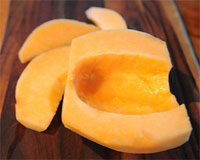
Cantaloupe
Cantaloupes and Muskmelons: In most cases, when cantaloupes and muskmelons are ripe, they detach themselves from the vine, leaving a dish-shaped scar on the fruit where the stem was attached. The fruit will also develop a sweet, musky aroma when ripe.
Honeydews: These green-fleshed melons don't slip from the vine or develop a strong aroma, so ripeness is a bit more difficult to detect. When ripe, the color of the rind should be a creamy yellow rather than green, and the rind will become smooth and waxy rather than dusky. If you press on the bottom of a ripe honeydew (the opposite end from where it's attached to the vine), it should feel slightly soft or at least a little springy.
Watermelons: Like honeydews, these melons don't have a scent or slip from the vine when they're ripe, but they do provide several clues that tell you they're ready to eat. Look for the small leaf and stem-like curl that occur near where the melon is attached to the vine. When watermelons are ripe, this leaf and tendril will turn brown and dry.
For more information, read How to Tell When Melons are Ripe
What should I use to mulch my vegetable garden? Not all vegetable plants like the same growing conditions, so it's best to pair the mulch with the crop. For instance, heat-loving peppers, tomatoes, eggplant and melons are great candidates for black plastic mulch. Applied in early spring, the plastic will raise soil temperatures and help warm the air around the plants. It presents a watering challenge, though. But most plastic mulches are not water-permeable, which means that as the season progresses, your plants might go thirsty. Inadequate moisture can stress your plants, lead to blossom-end rot problems on tomatoes, and diminish your overall harvest. To prevent problems, add a soaker hose under the mulch.
Cool-weather crops, such as broccoli and greens, don't want the extra heat from a plastic mulch. They'll be better off with straw, shredded leaves, paper mulch or newspaper. These mulches can lower soil temperatures by as much as 20 to 25 degrees, which may keep cool-weather plants producing right through the summer's heat.
For more mulch-crop pairings, read Choosing the Right Mulch for Vegetable Gardens.
How do I control Japanese beetles? They are everywhere! Japanese beetles can be devastating — especially on roses. You have several options for control:
Details on all of these techniques can be found in this article: Solutions for Japanese Beetle Control.
I have some old seeds. Should I try to sow them or should I assume they're no good? Although seeds are packed fresh each year, you can often get good results from seeds that are several years old. To decide if it's worth planting them, do a simple test.
The first step is to put 10 seeds in a damp paper towel and nestle it in a plastic bag for a few days — preferably in a spot that's about 70 degrees F. — or warmer.
Most seed packets will tell you "days to germination." After the expected number of days have passed, check to see how many sprout. If you get more than 50 percent germination, you might want to give it try, planting two or three seeds to a cell. If nothing sprouts, all you've lost is a paper towel and 5 minutes.
Some types of seed are good for four to five years, but others are more perishable.
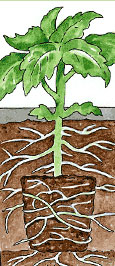
I was told to bury a portion of the stem when planting tomatoes. Is that right? Yes. It's a good idea to bury about 6" of stem. Just remove the leaves from the portion to be buried and plant it deep. When buried, tomato stems will sprout roots, resulting in a healthier, sturdier plant. Get details on this technique in our slideshow: Step by Step: Growing Tomatoes from Seed to Harvest
What's the right kind of soil for my new raised bed? For most situations, we recommend these proportions:
To calculate how much you need, use the Soil Calcluator. Keep in mind that proportions are approximate because soil volume varies from source to source. For instance, if the calculator specifies .444 cubic yards of soil for your bed, go ahead and round it up to a half yard.
Why are my seedlings so spindly? Weak, "leggy" growth is often the result of inadequate light, both in intensity and duration. Place seedlings under grow lights, arranging them so the lights are a few inches above the tops of the plants, and keep the lights on for about 14 to 16 hours per day. For more information, read the article How to Start Seeds.
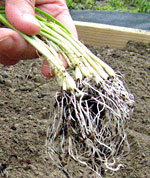
Onion seedlings
Should I plant onion sets, or start from seed? Sets are a good choice if you want scallions (green onions), but you're not likely to get large onions. Though it might sound unlikely, you'll get bigger onions if you start from seeds and seedlings. Learn all about it in Onions 101.
Can I throw coffee grounds in my compost? Coffee grounds are a fine addition to your compost, which depends on a mix of "green" (nitrogen) and "brown" (carbon) ingredients — about 3 parts brown to 1 part green. Despite their brown color, coffee grounds are "green," and a good source of nitrogen at a time of year when there's little green. For more information, read the article Compost Your Coffee Grounds.
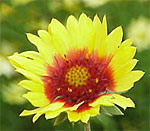
Blanket flower (Gaillardia x grandiflora) is one of many perennials that are easy to grow from seed.
Can I start perennials from seed? Yes, many perennials are easy to start from seed. Examples include coreopsis, dianthus and blanket flower. Some will bloom the first year if you give them a head start by sowing the seed indoors in early spring. For more information, read the article Grow Perennials from Seed.
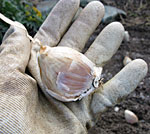
Can I just plant the garlic I get from the grocery store? You could, but supermarket garlic is not always the most flavorful, and it might have been treated with an anti-sprouting agent, so it might not grow well. It's better to buy garlic that's grown for planting. You'll find dozens of varieties, from spicy to mild. You can choose hardneck or softneck types. Softneck garlic is good in mild climates because it matures more quickly. Hardneck varieties tend to be more hardy, and they produce the edible scapes that some folks enjoy.
Once you harvest your first crop, you can save some for replanting. The largest cloves will yield the largest bulbs.
The Organic Garlic Collection includes at least a half pound of hardneck and softneck varieties, which will produce enough garlic for an average family of four. For more information, read Planting and Harvesting Garlic.
How long should I water? It depends on many factors: soil type, recent rainfall, weather conditions and more. To make sure your plants get enough water, check the soil with your built-in "moisture meter": your finger. It's better than any other tool. The soil should feel cool and moist at the root zone. A timer makes watering easy; just adjust the frequency as weather conditions change. For more information, read the article When to Water.
I have no fruit out; why do I have fruit flies? Look for spilled juice; also, cover your compost pail, rinse empty bottles in your recycling bin, cover ripening fruit (especially bananas) and, of course, get a fruit fly trap. For more information, read the article Fighting Fruit Flies.

Can peonies be divided? Yes. Unlike most perennials, peonies rarely need to be divided. The only reason to do it is to get more plants — or share them with friends. It's best done in the fall. Dig up the clump and use a sharp tool to divide it into sections, keeping three to five eyes in each division. Be sure to water the transplants thoroughly, unless you get plenty of rainfall. Keep in mind that divisions (and transplants) might not begin blooming again for two or three years. For more information, read Peony Care.
How do you take care of rhubarb in the off season? Rhubarb grows in cool weather — spring and fall — and goes nearly dormant in the summer, especially in hot weather. General care: fertilize in early spring, remove all flower stalks as they appear, pick off yellowing leaves as the plants go dormant in summer. After fall frost, remove and compost the mushy leaves, then add some compost or composted manure to the soil around the plants. For more information, see the entry on Rhubarb in the Vegetable Encyclopedia.
How do I get really blue hydrangeas? To encourage blue hydrangea flowers, grow the plant in soil that has a pH of 5.2-5.5. If your soil is more alkaline, you can lower the pH by applying Soil Acidifier at the rate specified on the package. Soil pH can also be lowered (more gradually) by applying an acidic organic mulch, such as pine needles or pine bark.
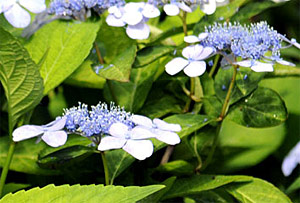
A lacecap-type hydrangea.
If the pH of your soil is naturally quite high (alkaline) it will be very difficult to get blue flowers — even if there's plenty of aluminum in the soil. Alkaline soil tends to "lock up" the aluminum, making it unavailable to the plant. However, you can grow fabulous pink hydrangeas.
More information: How to Grow Blue Hydrangeas, which explains the issue in more detail. There are many types of hydrangeas and not all of them can be made to produce blue flowers.
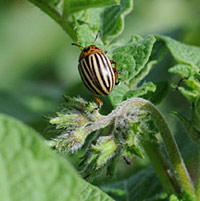
Colorado potato beetle. Photo: David Grist
What should I do about the beetles on my potato plants? Those are Colorado potato beetles, a pest that causes a lot of trouble for people who grow potatoes. Because of their distinctive striped bodies, adult beetles are easy to identify — and control: Just pick them off with your hands and toss them into a bucket of soapy water. The beetles might bother your plants for a few weeks; just keep monitoring and hand-picking and your plants will be fine.
If you plan ahead, you can shut out the beetles with garden fabric or Pop-Up Covers.
Tip: Before you see the beetles, look for the bright yellow eggs, which you'll find under the leaves. Rub them off with your finger.
More information: Controlling Colorado Potato Beetles.
Copyright © www.100flowers.win Botanic Garden All Rights Reserved